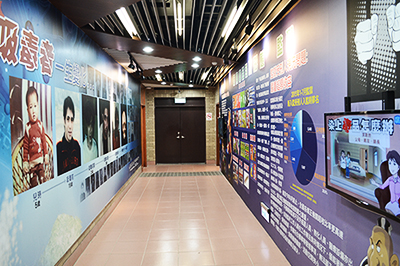One、Project Background

According to statistics of Ministry of Justice (2010), there are approximately 197,000 people prosecuted from January to November 2010. A large number of prosecution cases are related to violating safe driving due to drug use, estimated 31,000 cases. Apparently we ought to pay more attention to crimes and social safety problems caused by drug use. Given the latest statistics, there are three major trends: 1. Drug offenders have lower education levels (among those convicted in 2010, 34.6% are high school level, and 49.4% are are junior high school level). 2. The majority of drug offenders are juveniles (among those convicted in 2010, 35.1% are between 30 to 40 years old, 24.9% are between 24 to 29 years old, and 19.2% are between 18 to 23 years old). 3. Drug offense remains top of crime rate (42.8% of prison inmates in 2010 are drug offenders). Moreover, if categorized by crime committing frequency, in 2010 alone, among those newly imprisoned, 25,210 inmates are recidivists, which accounts for 67.8%. The number of recidivists continued to increase in the past five years mainly because of the increasing number of repetitive drug offenders. Again, drug offense rate takes up most of any convictions. In 2010, 92.2% convicted with drug offense are recidivists. Clearly the substance abuse problem is very serious. We ought to look into all possible aspects of substance abuse, such as the source, channel, correction rate of drug offenders, and analysis of cause of repetitive offense, etc., in order to enact a more efficient control over the problem, as well as reduce the hazard to general public.
Drug use of adolescents not only affects their physical and metal health, but also development. Juveniles are in the stage where they are not fully mature in mind to make correct judgements. It is when someone is the most easily temped by drugs due to misjudgment, sudden craving, or peer pressure. Once they fall onto the wrong path of drug use, they could be harmed both physically and mentally, and not be able to get out of it. According to the study of Substance Abuse Among Adolescents in Taiwan by Pi-Se Chou (1997), by late 1990’s, the rate of drug use among junior high school and high school students is 1.1%~1.4%. However, by 2003 and 2004, the drug use rate rises to 1.5%~1.6% (Wei-Chien Chen, 2002, 2003). In Wei-Chien Chen’s study per Illegal Drug Use Among Adolescents in Taiwan in three consecutive years between 2004 to 2006, it shows that the rate of male adolescent drug use is 2.5%, 11.65%, and 8.85% respectively, while the rate of female adolescent drug use is 1.3%, 10.44% and 4.31% respectively. In addition, conforming to the follow-up study of Drug Use Rate and its Related Psychologically Social Factors of College Students in Taiwan by Hui-Chen Ko (2006), 2.1% of college students are using drugs illegally. If we take the dropout rate of junior high school adolescents as a reference, 0.2%~0.33% of junior high school students dropped out from school between academic year of 2003 and 2008 (Department of Statistics, Ministry of Education, 2010). From these statics, we can see that the problem of illegal substance abuse is not limited to dropout adolescents who are usually more likely to committing such offense. Moreover, although the attendance rate of junior high school and high school in Taiwan remains high, between 2004 and 2009, 93.0%~97.49% of aged 12 to 14 attended junior high school, and 88.44% to 92.35% aged 15 to 17 attended high school. In other words, 3%~11% adolescents are indeed out of school. How are these young people supposed to learn about drugs and illegal medication? We ought to continue looking into the current situation and pattern of substance abuse among adolescents, as well as stopping them from temptations that ultimately misleads them astray and building a positive attitude and behavior against drug use.
Two、Purpose of Establishing The Education Center of Substance Abuse Prevention
The problem of substance abuse is overflowing and far-reaching on campuses in central and southern Taiwan. Schools overseas are beginning to raise anti-drug awareness on campus. For example, there is the Education Resource Center of Substance Abuse at King Mongkut's University of Technology in Bangkok, Thailand, and Drug Information Center in Hong Kong. On the other hand, there is only Anti-Drug Gallery by Ministry of Justice Investigation Bureau in northern Taiwan, which exhibits anti-drug information. It is rather difficult to access by students for the nature of its establishment.
Education Center of Substance Abuse Prevention aims implement an early education about drugs for young students in Taiwan, help them understand reasons and serious consequences of drug use, as well as raise their vigilance and awareness for drug prevention. This center is originally planned by National Chung Cheng University, and established under instructions by Department of Student Affairs and Special Education, Ministry of Education. There are three major missions for the center: research & study, plans & establishment of Education Center of Substance Abuse Prevention, and dissemination of anti-drug educational events. Firstly, the execution of academic research and study gives a throughout insight of current situation of substance abuse, as well as evaluation of anti-drug educational demand for adolescents in Taiwan. Meanwhile, space planning and construction setups are in preparation for Education Center of Substance Abuse Prevention. Lastly, the center works together with NGOs and CCU student organization of anti-drug dissemination to host events at all schools nationwide, as well as invite students from all over the country to visit Education Center of Substance Abuse Prevention.
The establishment of Education Center of Substance Abuse Prevention not only fills the vacancy of an information center of substance abuse in southern Taiwan, but also provides channels for young students in central and southern Taiwan to lean extensively about drugs and how-to-say-no-to-drugs. In the perspective of education, the center combines resources from public sectors (Ministry of Education, Ministry of Justice, Ministry of Health and Welfare, Ministry of The Interior, etc.) to work together in substance abuse prevention.

